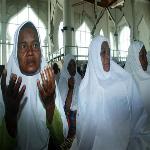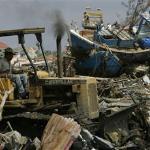25 December 2009

Photo: AP
Acehnese women take part in a prayer for the victims of Indian Ocean tsunami in Lhoong, Aceh province, Indonesia, 25 Dec 2009
It has been five years since a catastrophic tsunami devastated coastlines across Asia and Africa, killing more than a quarter of a million people. More than 160,000 Indonesian's died, most of those in Aceh Province, where half a million were also left homeless. Many houses remain empty and hundreds of families are awaiting permanent resettlement.
It is almost impossible to imagine or describe the scale of the disaster that struck Aceh on December 26, 2004. The tsunami's crashed over hundreds of miles of coastline; so forceful, that in many places, the landscape has been altered forever.
Ade remembers waves taller than the coconut palms. She managed to rescue her son, but her mother and sister were killed. So too were most of the people from her West Aceh village.
They took refuge with her husband's family in a village nearby. Soon the Spanish Red Cross arrived to build her family a neat, concrete home. It stands barely 500 meters from the ocean, but Ade says she is not afraid. She says she likes its new tiles and garden, and it has much more space.
But all around her other houses like it stand empty.
Ade explains they belong to orphaned children, who are now living with relatives. She hopes that one day they will return with children of their own.

AP
A bulldozer clears the rubble backdropped by a ship swept ashore by the Dec. 26 tsunami in Banda Aceh, Sumatra island, Indonesia, 08 Jan 2005The U.N. Development Program estimates that between 10 and 20 percent of homes built for tsunami victims remain unoccupied.
Simon Field heads the UNDP Aceh mission. "A number of people decided that they did not want to live in that location, near the coast and have relocated but they wanted to access their right and their entitlement to get a house from the reconstruction process and they are in the process of renting their house," he said.
Field says as well as orphans, widows received homes, but many have since remarried and moved from their villages. And, he concedes, some houses were built for the dead.
"Then there are definitely cases where houses were built, when most likely the person and all members of the family had passed away in the tsunami," said Field.
While thousands of houses lie empty across the province, on the outskirts of the capital Banda Aceh, several hundred families are living in supposedly temporary accommodation.
"Because I am long-time living in Longha, I can different [sic] what is wave sound, what is wind sound," said Ani. "When I hear a sound like strong wind, but I think that is not strong wind that is a wave! Some people say this is a crazy family because they run, run."
Ani has lived at Barak Bakoi, with her husband and four children for nearly five years. Each family has one room, divided by a thin wall, in long wooden halls. As many as 500 people still live in the camp.
Ani says people are often sick because of poor sanitation. And sometimes there is no running water.
(QUESTION): "And what happened to your home or your village in the tsunami?"
(ANSWER): "Broken . My village broken, including my house. But rented house, not mine."
Confronted with the task of rebuilding more than 130,000 homes, authorities gave priority to original house and land owners. A task made more difficult because of the destruction of records of land titles and the loss of physical land.
It is only in recent years the government and official reconstruction agency began focusing on housing solutions for renters and illegal squatters, who also lost their homes. They plan to provide poor households, not just tsunami victims, with a home within three years.
Simon Field says the scale of the disaster in Aceh was unprecedented and the experience has inspired new approaches to delivering relief.
"Instead of going and actually building the houses, the best approach is to identify the individuals who should be compensated and give them the funding," he said. "They know how to build houses or how to get people to build their houses, the key thing is for the government and donors to provide advice on earthquake-resistant houses."
Improving the ability of houses to withstand disasters and delivery of aid in the aftermath is essential for Indonesia to confront inevitable rumblings of the formidable so-called "Ring of Fire" circling its many islands.